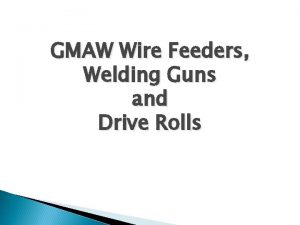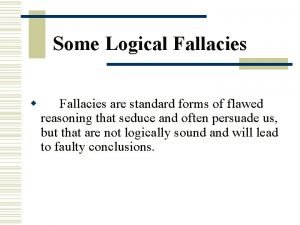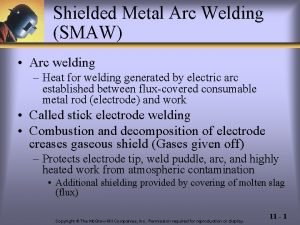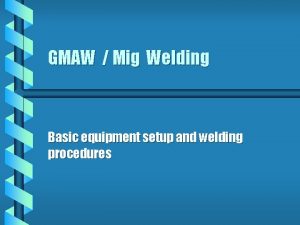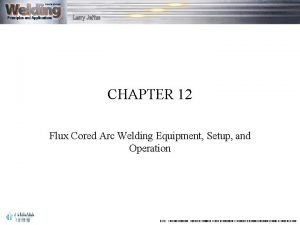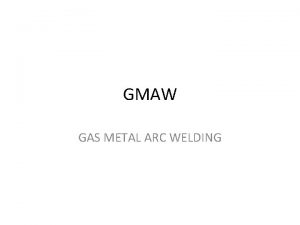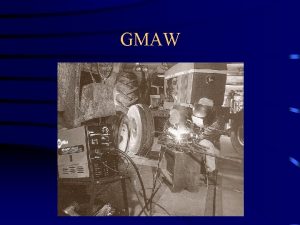GMAW Wire Feeders Welding Guns and Drive Rolls








- Slides: 8

GMAW Wire Feeders, Welding Guns and Drive Rolls

GMAW Wire Feeders: � The wire feeding unit, or wire driver, as it is sometimes called, is an essential part of the equipment required to perform the GMAW process. � The main function of the wire feed unit is to feed the electrode wire, at a constant rate, to the welding arc. � Other functions of the wire feeder are to transfer the welding current from the power source to the electrode wire and deliver shield to the weld puddle. � All wire feed units are rated for their minimum and maximum current capacity. � There are two basic types of wire feeder units; the fixed voltage type and the variable voltage type. �

� Fixed Voltage-Constant Speed Wire Feeder: ◦ As the name indicates, the fixed voltage type of wire feeder operates at a fixed voltage level and delivers constant wire feed speed. ◦ The fixed voltage type of wire feeder receives incoming power from the power source. ◦ The Fixed Voltage-Constant Speed type of wire feed unit is used for all types of arc transfer, but is best suited for the short circuit and pulse spray modes of metal transfer. ◦ The Fixed Voltage-Constant Speed is the most common type of wire feed unit, especially for production welding applications.

� Voltage Sensing-Variable Speed Wire Feeder: ◦ The Voltage Sensing-Variable Speed Wire Feeder operates at varied voltage levels. ◦ The Voltage Sensing type of wire feeders are designed to operate off the open circuit voltage of the power source (when welding is taking place). ◦ The voltage sensing type of wire feeder constantly monitor the arc voltage when welding is taking place and increases or decreases the wire feed speed when changes in voltage are sensed. (Engine driven power source) ◦ The voltage sensing type of wire feeder is capable of performing all types of arc transfers but is best suited for the spray arc mode of metal transfer and for use with FCAW electrodes.

◦ Some voltage sensing types of wire feeders are equipped with circuitry that allows them to be switched to constant speed operation. ◦ Voltage Sensing wire feeders are highly portable and are capable of running either constant current or constant voltage power source output. ◦ Voltage Sensing wire feeders are most commonly associated with portable welding of field work.

� Drive Rolls: ◦ The device inside the wire driver that facilitates the movement of the electrode from the spool, through the welding gun and to the welding arc. ◦ There are four basic types of drive rolls; �V-Groove Rolls �V-Groove rolls designed for use with hard wire or solid electrode wires. �U-Grooved Rolls �U-Groove rolls designed for the use with soft electrode wires of soft-shelled cored electrode wires. �V-Knurled Rolls �V-Knurled rolls designed for use with hard–shelled cored wires. �U-Cogged Rolls �U-Cogged rolls are designed for use with extremely soft electrode wires or soft-shelled cored wires such as hard facing electrodes. ◦ All drive rolls should be matched to the type of electrode being used and should be replaced when they are worn to the point that welding performance is effected.

� � � The Welding Gun: The welding gun/cable assembly is the device that brings all of the essential ingredients (welding current, electrode wire and shielding gas) together. Welding guns are rated for use based on three criteria; 1. Minimum and maximum electrode diameter. 2. Current carrying capacity or current rating. 3. Shielding gas that item number two is based on (carbon dioxide vs. argon) � � Welding guns/cables assemblies are rated so that the correct gun can be chosen for a specific application. Welding guns/cables should not be used for applications beyond their rating. Welding guns/cables are available in a number of lengths, gun configurations and can be air cooled or water cooled. Extremely long gun/cable assemblies may integrate a secondary wire drive into the welding gun for a push and pull electrode delivery system.

� � Welding Liner or Conduit ◦ Device within the cable/gun assembly that facilitates smooth delivery of the electrode wire from the feeder to the gun. Contact Tip ◦ The device that passes the welding current to the electrode wire in a GMAW welding gun.
